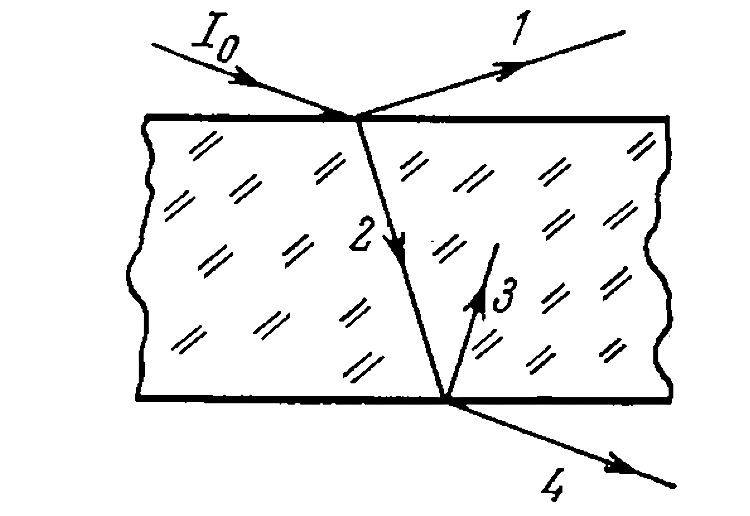A plane beam of natural light with intensity I0 falls on the surface of water at the Brewster angle. A fraction ρ=0.039 of luminous flux is reflected. Find the intensity of the refracted beam.
In this case from Fresnel's equations
I'⊥=I⊥sin2(θ1−θ2)sin2(θ1+θ2)
we get I1=(n2−1n2+1)2I0ρI0 say then I2=(1−ρ)I0,I3=ρ(1−ρ)I0
(ρ is invariant under the substitution n→1n)
finally I4=(1−ρ)2I0=16n4(n2+1)4I0=0.726I0.
(b) Suppose ρ'= coefficient of relection for the component of light whose electric vector oscillates at right angles to the incident plane.
From Fresnel's equations ρ'=(n2−1n2+1)2
Then in the transmitted beam we have a particlly polarized beam which is a superposition of two (∣∣&⊥) components with intensities
12I0&12I0(1−ρ')2
Thus P=1−(1−ρ')21+(1−ρ')2=(n2+1)4−16n4(n2+1)4+16n4=1−0.7261+0.726=0.158
Topper's Solved these Questions
- OPTICSBOOK - IE IRODOV, LA SENA & SS KROTOVCHAPTER - OPTICSEXERCISE - Dispersion And Absorption Of Light
24 Videos
- OPTICSBOOK - IE IRODOV, LA SENA & SS KROTOVCHAPTER - OPTICSEXERCISE - Optics Of Moving Sources
22 Videos
- OPTICSBOOK - IE IRODOV, LA SENA & SS KROTOVCHAPTER - OPTICSEXERCISE - Diffraction Of Light
60 Videos
- MECHANICSBOOK - IE IRODOV, LA SENA & SS KROTOVCHAPTER - MECHANICSEXERCISE - Mechanics Problems
92 Videos
- OSCILLATIONS AND WAVESBOOK - IE IRODOV, LA SENA & SS KROTOVCHAPTER - OSCILLATIONS AND WAVESEXERCISE - Electromagnetic Waves, Radiation
36 Videos
Similar Questions
A narrow beam of natural light falls on the surface of a thick transparent plane-parallel plate at the Brewster angle. Its top surface. Find the degree of polarization of beams 1−4 (Fig.)

View SolutionA beam of plane-polarized light falls on the surface of water at the Brewster angle. The polarization plane of the electric vector of the electromagnetic wave makes an angle φ=45∘ with the incidence plane. Find the reflection coefficient.
View Solution
Knowledge Check
An unpolarised beam of intensity I0 falls on a polariod. The intensity of the emergent light is :
AI02BI0CI04DZeroA parallel beam of monochromatic light is incident on the surface of water having refractive index 4/3. The direction of the incidence beam bisects the angle between the normal to the water surface and the water surface. The angles of incidence and refraction are
Ai=30∘,r=20∘Bi=45∘,r=20∘Ci=45∘,r=32∘Di=60∘,r=40∘Unpolarized light of intensity I0 is incident on surface of a block of glass at brewster's angle. In that case, which one of the following statements is true-
Areflected light is completely polarized with intensity less than I0/2Btransmitted light is completely polarized with intensity less than I0/2CTransmitted light is partially polarized with intensty I0/2Dreflected light is partially polarized with intensity I0/2
A beam of natural light falls on the surface of glass at an angle of 45∘. Using the Fresnel equations, find the degree of polarization of
(a) reflected light,
(b) refracted light.
View SolutionUnpolarised light of intensity I0 is incident on surface of a block of glass at Brewster's angle. In that case which one of the following startements is true?
View SolutionA circular beam of light (diameter d) falls on a plane surface of a liquid. The angle of incidence is 45∘ and refractive index of the liquid is μ. The diameter of the refracted beam is
View SolutionAn unpolarized beam of light has intensity I0 . It is incident on to ideal polarizing sheets . The angle between the axes of polarization of these sheets is θ . Find θ if the emerging light has intensity I0/4)
View SolutionAn unpolarized light beam is incident on a surface at an angle of incidence equal to Brewster's angle. Then,
View Solution
